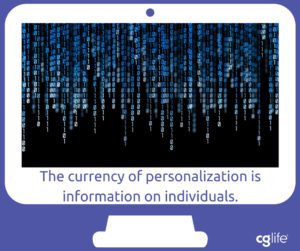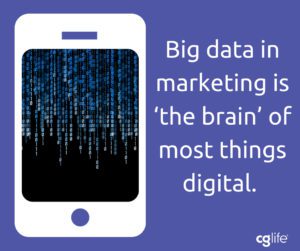

Digital Marketing Strategy Best Practices Part 2: Big Data In Marketing Innovation
Big data is a complex topic.
You can think of big data like visiting a new city. There are seemingly infinite varieties of people to meet, places to go, and things to do, but it’s really up to you what you make of it. While there exist many different outcomes and paths to get wherever you want to go, knowing how to get there efficiently and defining the goal is what matters.
If you’re wondering how this applies to life science marketing, we will break this idea down by exploring its real life application.
Big Data In Marketing
Marketers use data to entice people to want to buy things they are already interested in. The future of ads is personalization, and the currency of personalization is information on individuals.
Personalizing your data is basically an application of the ‘Internet of Things’. The Internet of Things is the collection of devices and programs used by an individual that are connected to the internet. Data on each of these “things” is more and more helpful to users because the devices adapt to how you use them. In order for these devices to adapt and learn, they must be picking up and processing data.
To make that data useful, it must be taken somewhere to be stored, meaning whatever device, program, or app you use, the data must first be sent back to a server somewhere to be processed. Bulk data gathered in large campaigns must be housed in specialized systems like Amazon Web Services (AWS). AWS houses large amounts of data, and many advertising technology platforms run on it or other, similar cloud storage platforms.
Marketers are using personalization in popular applications like Waze. Waze learns your daily route, resulting in ads appearing for companies and services that are along that route. Let’s say on your way to work you occasionally stop for coffee. A personalized ad for coffee will be served to you: “Starbucks Iced Coffee, .01-mile detour, 1 minute away.” Your personalized data is useful because the ad you are getting is HIGHLY relevant to you.

Personalization comes from trends in data. Likewise, for a digital marketing campaign, you will typically see data come in, reported in metrics like clicks, impressions, and site visits. This sounds simple until you start expanding the data and digging into the day-over-day data to help you ask the more complex questions, so that you can analyze the data to inform other parts of your marketing strategy.
For example, if you wanted to know what time of day your ad gets the most impressions, you could look at hour-over-hour data. If you wanted to see which creative element is performing best, then you could just look at a new view of that same data. Likewise, if you wanted to see which sites your ad was running on, you could look at yet another view. This is how marketers are taking large data sets and drawing conclusions from trends in that data after doing some analysis.
Why Data Matters To Marketing In The Life Sciences
So, why does data matter in marketing in the life sciences field? When the data is applied correctly you can see increases in reach and effectiveness, and overall increases on the return on your ad spend.
Let’s look at an example—take a made-up Company ABC and their newly developed drug that helps treat early-onset Alzheimer’s. Traditionally, they will have a press release that includes their published research. However, if their advertising budget is limited and they want to maximize their brand and drug awareness, how would they go about doing so? Instead of spending their budget randomly and hoping it sticks, they could turn to data and the programmatic process of advertising.
By using data, Company ABC will be able to isolate the audience they want to target. Let’s say they know that their market is primarily focused on medical professionals in the 25-49 age range. Using and analyzing this data as a base, they can focus their marketing budget toward attracting their target audience. By targeting these people specifically, they will have a much higher rate of building their brand awareness and potential sales without spending much or, ideally, any of their budget on individuals who aren’t representative of their intended market.
Good Data Must Be High Quality
The first concern about data is ensuring that it’s high quality by analyzing it for discrepancies and errors. This does not mean that statistical outliers are removed, but rather that data containing obvious errors or inconsistencies are removed.
We have access to more and more data simply due to the proliferation of technology. Digital technology allows us to easily record an astounding amount of data. Big data is everywhere and is an essential component to many technologies.

Consider how this data is used and collected. If we focus on a smaller market of individuals who use smart watches or smart bands, we can glean insights into their lives using data, and may begin to identify emerging trends such as whether groups of people workout at the same time, on specific days, if they wake up and sleep at the same time, and if are they active or inactive during the same time frames every day. Each of these questions (and more) can be put into a predictive model to uncover high-probability trends on what these individuals will do in the future.
The key takeaway for big data is that it is the ‘the brain’ of most things digital. With so much information to be gleaned, the uses are near limitless; it’s only a matter of applying the data to your goals.
What Does Big Data Include?
Big data includes all the input received from whatever is happening. If you are wearing a smartwatch, there are tons of data being received about your daily activities. If it has GPS that measures how far you ran, then it records data on distance, duration, and your heart rate throughout the entire run. Your device not only records active data, but passive data is also recorded and stored throughout the day that can lend insight to your daily life and behaviors.
Each of these odd, one-off data points are combined to give you the vast, seemingly endless collection of big data. This collection of data points is HUGE. The more data that is collected, the more valuable it is, if used correctly.
More data you have it also means more the more expensive it is. It takes a large amounts of digital storage to store all this data. That is where technology like Google Big Query and Amazon Web Services (AWS) S3 servers come into play.
These are ‘cloud’ based platforms that essentially take your data and put it in a giant ‘self-storage’ space online. Naturally, the more data you use and collect, the more storage space you need. The more space you need, the more costly it is.
The data processing power also comes into play here. If you are always having your data run through algorithms, it is going to take even more computer brain power to analyze and make sense of it.
There are piles of data out there, representing information on top of information on top of information. So much that it will paralyze your super advanced personal computer. There are cloud computing companies that are used to house it all and, depending on what questions you are looking to answer, can tell you what your data means.
Using Data To Predict Behavior
Marketing data aims to define a particular target audience based on their background, average age, and gender with a model. Using big data to model such information, we can create predictions about this audience’s interests or preferences. You can start to make predictions about who will be interested and in what based on demographic and historical data. For healthcare marketing, due to HIPPA, we do not have access to any personally identifiable health procedural data or hospital data for individuals, but we have enough data to create other representative models.
If we want to target healthcare professionals, we can use big data to create predictive models to figure out their demographic or psychographic profiles. We can even go as far as to create “look alike” models using machine learning to identify audiences that would be interested in our products or services. Thus, we work with “big data” because, simply, there are vast amounts of accumulated historical data available, and it’s growing all the time, in real time.
There is so much access these days to data, you literally have no excuse for not using it. Using data for predictive modeling, assessing trends, personal behaviors, or to hone in on a particular customer demographic, is smart marketing, and done well, can help your business gain friends and influence people, and not in a creepy way.
Stay tuned for our exclusive eBook download, “A Digital Advertising Technology Primer: The Dos, The Hows, The Whats” coming soon.
Contact us to find out how to incorporate personalization into your digital advertising strategy.
